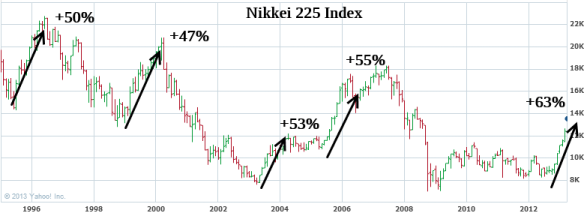In case you haven’t been paying attention, the Japanese stock market is on an epic run. The Nikkei 225 is up 60% since last November when government officials began hinting at big policy changes that have since come to be known as “Abenomics”. Abenomics is essentially a strategy where the government will throw everything including the kitchen sink at the economy. So they’ve announced a huge fiscal package, an inflation target and a massive QE program. I’ve said that the policy has the potential to completely alter the landscape of future policy.
If the Japan experiment ends up generating signs of a robust recovery and an end to the persistent Japanese deflation we will see much more aggressive policy stances around the world. In fact, it might already be influencing the world’s policymakers.
But should we automatically assume that the Nikkei index is a sure sign that this is all “working”? I think we need to look a bit more closely. And a close inspection of the Nikkei index shows that this isn’t the first time the index has surged 50%+ in a brief period of time. You might be surprised to notice that the Nikkei doesn’t really trade like a developed market at all. It actually trades more like a high beta developing nation. That is, the volatility and extreme swings in the index are enormous (see figure 1).
Now, I am not arrogant enough (or stupid enough) to say that Abenomics will fail (though that doesn’t imply I am not stupid!). I think there are components of it that are quite good and components of it that are bad. But we should be careful about gleaning too much from the sharp rise in the stock market. After all, it’s not the first time this index has shot higher during their bout with deflation.
Mr. Roche is the Founder and Chief Investment Officer of Discipline Funds.Discipline Funds is a low fee financial advisory firm with a focus on helping people be more disciplined with their finances.
He is also the author of Pragmatic Capitalism: What Every Investor Needs to Understand About Money and Finance, Understanding the Modern Monetary System and Understanding Modern Portfolio Construction.


Comments are closed.